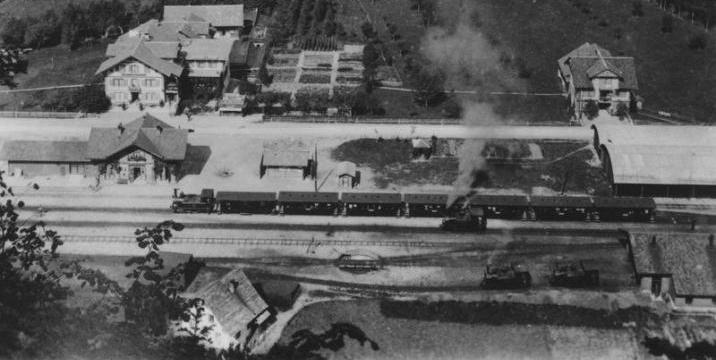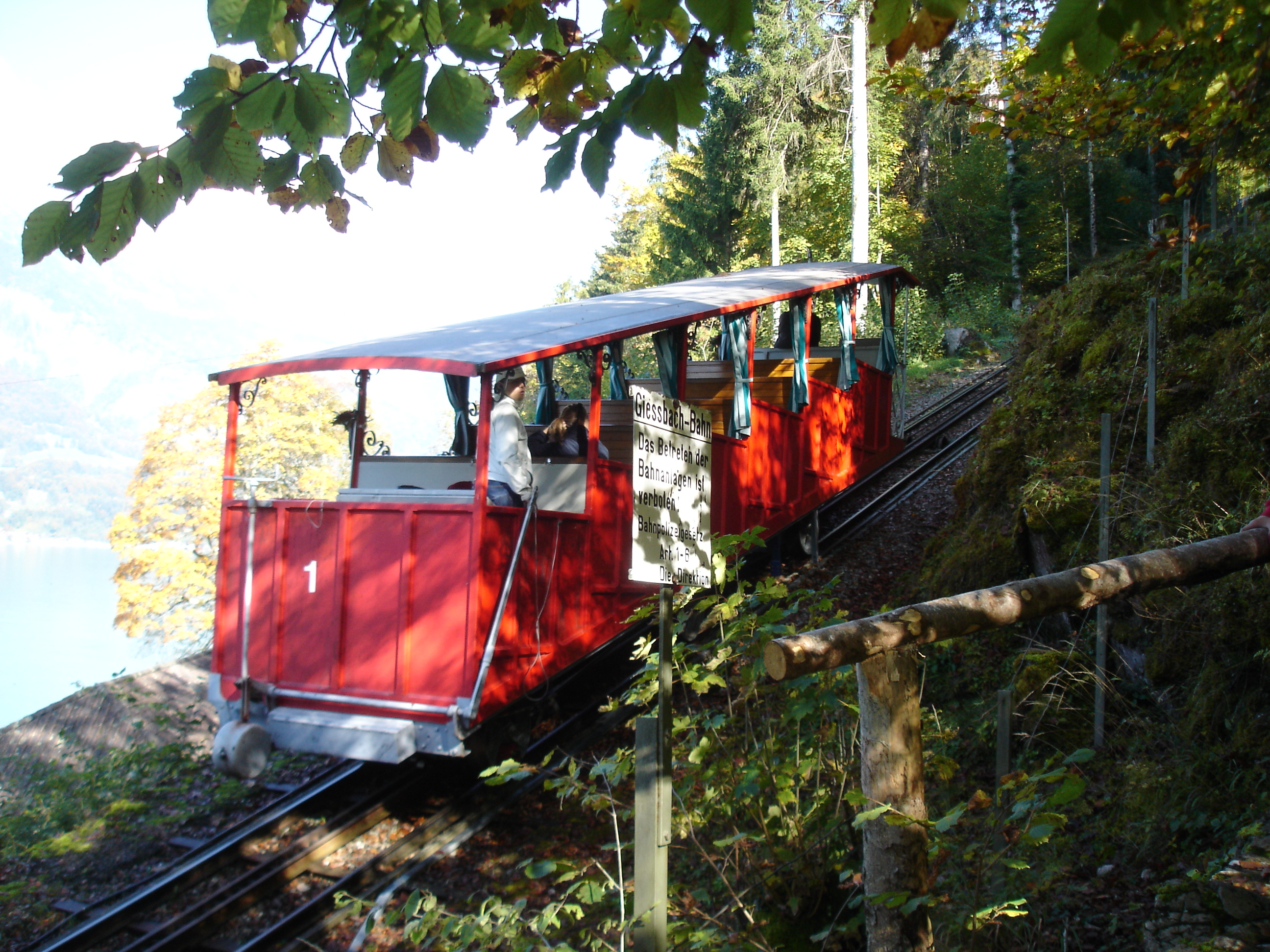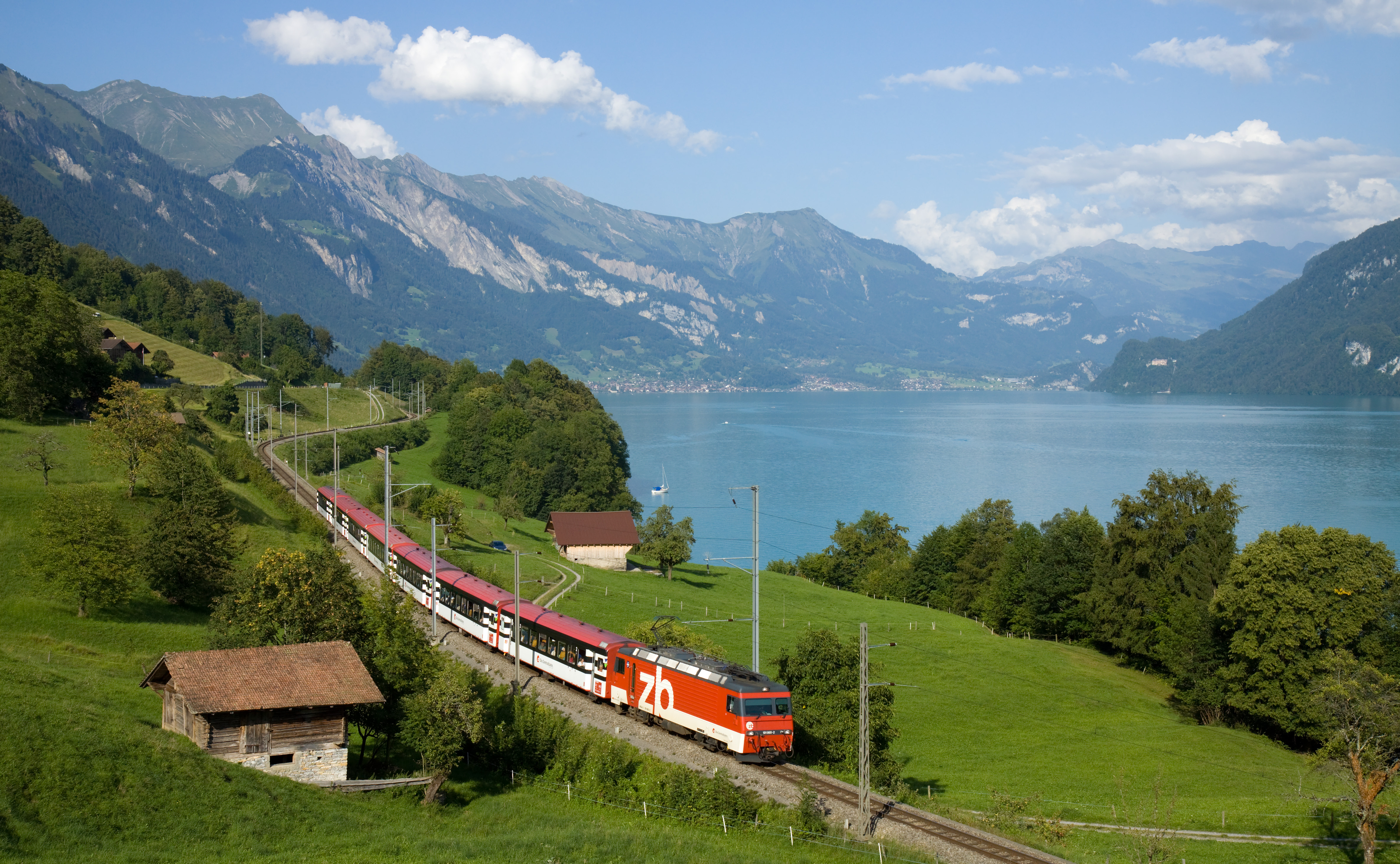|
Brienz BRB Railway Station
Brienz BRB railway station (german: Bahnhof Brienz BRB) is a railway station in the municipality of Brienz, in the Swiss canton of Bern. It is the lower terminus of the Brienz–Rothorn rack railway (BRB) that climbs to the summit of the Brienzer Rothorn mountain. The station is located across the street from Brienz railway station on the gauge Brünig line of Zentralbahn with service to and . Connections are also available to local bus network provided by PostBus Switzerland, and shipping services operated by the BLS AG on Lake Brienz at an adjacent quay. Amongst other destinations, buses link to the Ballenberg open-air museum, whilst boats link to the lower station of the Giessbach Funicular, which gives access to the Giessbach Falls. The station opened in 1892, four years after the Jura–Bern–Lucerne Railway The Bernese Jura Railway (''Chemins de fer du Jura bernois'', abbreviated ''Jura bernois'', JB) was a railway company in Switzerland. The company was called th ... [...More Info...] [...Related Items...] OR: [Wikipedia] [Google] [Baidu] |
Brienz
Brienz ( , , ) is a village and municipality on the northern shore of Lake Brienz, at the foot of the Brienzer Rothorn mountain, and in the Bernese Oberland region of Switzerland. Besides the village of Brienz, the municipality includes the settlements of Kienholz and Axalp. Politically, the municipality is located in the Interlaken-Oberhasli administrative district of the canton of Bern. History The first settlements date from the neolithic and Bronze Ages. In the 5th century BC, the Celts settled in the alpine valleys among the sources of the Rhone, the Rhine and the Danube, eventually stretching from the headwaters down to Vienna and Belgrade. At the end of 1st century BC the Romans conquered this area. The Roman settlements were destroyed by the Alamanni in 259/60. They eventually settled in the area around 450. In any case, evidence has been found for a settlement by the Alamanni in the 7th century. Brienz is first mentioned in 1146 as ''Briens''. In 1528, after ... [...More Info...] [...Related Items...] OR: [Wikipedia] [Google] [Baidu] |
PostBus Switzerland
PostAuto Switzerland, PostBus Ltd. (known as in Swiss Standard German (), in Swiss French (), in Swiss Italian (), and in Romansh () is a subsidiary company of the Swiss Post, which provides regional and rural bus services throughout Switzerland, and also in France, Germany, and Liechtenstein. The Swiss PostAuto service evolved as a motorized successor to the stagecoaches that previously carried passengers and mail in Switzerland, with the Swiss postal service providing postbus services carrying both passengers and mail. Although this combination had been self-evident in the past, the needs of each diverged towards the end of the twentieth century, when the conveyance of parcels was progressively separated from public transportation. This split became official with the conversion of PostAuto into a separate subsidiary of the Swiss Post in February 2005. The buses operated by PostAuto are a Swiss icon, with a distinctive yellow livery and three-tone horn. The company uses ... [...More Info...] [...Related Items...] OR: [Wikipedia] [Google] [Baidu] |
Railway Stations In Switzerland Opened In 1892
Rail transport (also known as train transport) is a means of transport that transfers passengers and goods on wheeled vehicles running on rails, which are incorporated in tracks. In contrast to road transport, where the vehicles run on a prepared flat surface, rail vehicles (rolling stock) are directionally guided by the tracks on which they run. Tracks usually consist of steel rails, installed on sleepers (ties) set in ballast, on which the rolling stock, usually fitted with metal wheels, moves. Other variations are also possible, such as "slab track", in which the rails are fastened to a concrete foundation resting on a prepared subsurface. Rolling stock in a rail transport system generally encounters lower frictional resistance than rubber-tyred road vehicles, so passenger and freight cars (carriages and wagons) can be coupled into longer trains. The operation is carried out by a railway company, providing transport between train stations or freight customer faciliti ... [...More Info...] [...Related Items...] OR: [Wikipedia] [Google] [Baidu] |
Jura–Bern–Lucerne Railway
The Bernese Jura Railway (''Chemins de fer du Jura bernois'', abbreviated ''Jura bernois'', JB) was a railway company in Switzerland. The company was called the Jura–Bern–Luzern (''Jura–Bern–Lucerne'', JBL) from 1 July 1884. The Jura–Bern–Lucerne merged with the Western Switzerland–Simplon Railways (''Suisse-Occidentale–Simplon'', SOS) to form the Jura–Simplon Railway (''Jura-Simplon-Bahn''), JS) on 1 January 1890. History The railway network of the Canton of Bern initially developed according to the interests of the Swiss Central Railway (''Schweizerische Centralbahn'', SCB). The Grand Council of Bern, decided to conclude a contract with the SCB in 1852. The Central Railway undertook to build the Murgenthal–Bern line and the Solothurn–Herzogenbuchsee railway within four years and in return received tax exemption and the privilege of being given preferential treatment in future grants of concessions to build railways. The Central Railway’s construct ... [...More Info...] [...Related Items...] OR: [Wikipedia] [Google] [Baidu] |
Giessbach Funicular
The Giessbach Funicular (german: Giessbachbahn) is a historic funicular in the Swiss canton of Bern and municipality of Brienz. It links a landing stage on Lake Brienz, served by shipping services on the lake, to the Grand Hotel Giessbach and Giessbach Falls above. The funicular is owned by the hotel, but since 1983 has been operated by a preservation foundation. Description The Giessbach funicular was designed by the Swiss engineer Carl Roman Abt. When it was opened in 1879, it was the first funicular with a two-rail single track layout with a relatively short passing loop in the middle. Its turnouts had no moving parts, which was quite a remarkable achievement for the time. Abt had later developed its modification which became known as the ''Abt Switch''. Originally the funicular was powered by water ballast, and the Riggenbach rack rail in the middle of the track was used for speed control. In 1912 the water ballast system was replaced by a hydraulic engine powered by a Pe ... [...More Info...] [...Related Items...] OR: [Wikipedia] [Google] [Baidu] |
Ballenberg Open-air Museum
Ballenberg is an open-air museum in Switzerland that displays traditional buildings and architecture from all over the country. Located near Brienz in the municipality of Hofstetten bei Brienz, Canton of Bern, Ballenberg has over 100 original buildings that have been transported from their original sites. It is a Swiss heritage site of national significance. In addition to the main attraction of the buildings themselves, some of the industrial and crafting buildings still operate to give demonstrations of traditional rural crafts, techniques and cheesemaking. There is also a sizable number of farmyard animals in the grounds. Founded in 1978, the museum features buildings from all over the country and has structures from almost all of the cantons. The buildings are set in surroundings appropriate to their type (farm buildings surrounded by small fields etc.) with pathways snaking across the 660,000 square metres (164 acre) site. Most buildings allow the visitor to walk around the ... [...More Info...] [...Related Items...] OR: [Wikipedia] [Google] [Baidu] |
Lake Brienz
Lake Brienz (german: Brienzersee) is a lake just north of the Alps, in the canton of Bern in Switzerland. It has a length of about , a width of and a maximum depth of . Its area is ; the surface is above the sea-level. It is fed, among others, by the upper reaches of the Aare at its eastern end, the Giessbach at its southern shore from steep, forested and rocky hills of the high Faulhorn and Schwarzhoren more than above the lake, as well as by the Lütschine, flowing from the valleys of Grindelwald and Lauterbrunnen, at its southwestern corner. It flows out into a further stretch of the Aare at its western end. The culminating point of the lake's drainage basin is the Finsteraarhorn at 4,274 metres above sea level. The village of Brienz, from which the lake takes its name, lies on the northern shore to its eastern end. In the west, the lake is terminated by the Bödeli, a tongue of land that separates it from neighbouring Lake Thun. The village of Bönigen occupies the lake fr ... [...More Info...] [...Related Items...] OR: [Wikipedia] [Google] [Baidu] |
Zentralbahn
The Zentralbahn is a Swiss railway company that owns and operates two connecting railway lines in Central Switzerland and the Bernese Oberland. It was created on January 1, 2005, with the acquisition of the independently owned Luzern–Stans–Engelberg line, and the Brünig line of the Swiss Federal Railways. The company has its headquarters in Stansstad. The railway owns the infrastructure of the long inter-regional Brünig line, which links Lucerne and Interlaken over the Brünig Pass, and the long Luzern–Stans–Engelberg line from Hergiswil, on the Brünig line some out of Lucerne, to Engelberg. Both lines are built to the , and use rack railway technology to climb their steepest gradients, although most of both lines uses conventional adhesion. The railway operates two hourly InterRegio express services, one between Lucerne and Interlaken, and one between Lucerne and Engelberg. It also operates two half-hourly services of the Lucerne S-Bahn, the S4 between L ... [...More Info...] [...Related Items...] OR: [Wikipedia] [Google] [Baidu] |
Switzerland
). Swiss law does not designate a ''capital'' as such, but the federal parliament and government are installed in Bern, while other federal institutions, such as the federal courts, are in other cities (Bellinzona, Lausanne, Luzern, Neuchâtel, St. Gallen a.o.). , coordinates = , largest_city = Zürich , official_languages = , englishmotto = "One for all, all for one" , religion_year = 2020 , religion_ref = , religion = , demonym = , german: Schweizer/Schweizerin, french: Suisse/Suissesse, it, svizzero/svizzera or , rm, Svizzer/Svizra , government_type = Federalism, Federal assembly-independent Directorial system, directorial republic with elements of a direct democracy , leader_title1 = Federal Council (Switzerland), Federal Council , leader_name1 = , leader_title2 = , leader_name2 = Walter Thurnherr , legislature = Fe ... [...More Info...] [...Related Items...] OR: [Wikipedia] [Google] [Baidu] |
Brünig Railway Line
The Brünig railway line (german: Brünigbahn) is a Swiss narrow gauge railway line that links Lucerne, in central Switzerland, with Interlaken, in the Bernese Oberland. The line runs via Alpnachstad, Giswil, Meiringen and Brienz, and passes over the Brünig Pass, using sections of rack railway to overcome the gradients, but with most of the line operated by normal adhesion methods. The line is long. It opened in stages between 1888 and 1916, and was, between 1903 and 2004, the only narrow gauge line of the Swiss Federal Railways. Today the line forms part, along with the Luzern–Stans–Engelberg line, of the Zentralbahn company. The line is served by InterRegio trains that operate the full length of the line, with regular (non-rack) Regio trains between Interlaken and Meiringen, and Lucerne S-Bahn trains between Lucerne and Giswil. The section between Hergiswil and Lucerne is shared with the Luzern–Stans–Engelberg line. History The line was constructed by the ... [...More Info...] [...Related Items...] OR: [Wikipedia] [Google] [Baidu] |




